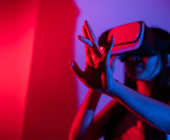| Toolkit To Cut VR Cybersickness Released |
| Written by Kay Ewbank | |||
| Wednesday, 15 July 2020 | |||
|
An open source software toolkit for Unity that aims to reduce cybersickness when using virtual reality holds the promise of welcome relief to many VR headset users. GingerVR was named after the plant which is often used as an antidote for nausea, one of the classic symptoms of cybersickness. Cybersickness is the term used to describe the feelings of nausea and discomfort experienced by many people when they use a virtual reality headset, and it's one of the main things holding back the popularity of VR. Despite this, many companies are experimenting with VR, not just for gaming but for more general use. Finding a way to cut down on the symptoms of cybersickness would be a significant advance.
John Quarles, an associate professor in the Department of Computer Science at the University of Texas as San Antonio (UTSA) who developed the toolkit along with PhD student Samuel Ang, said that the research literature indicates that more than half of VR users experience symptoms of cybersickness, though this does cover a wide range of severity and claimed: “GingerVR can be applied to any Unity application, be it a game, enterprise application or job training,” Unity is best know as a gaming platform, but the company has been moving into the business application sector, with plans for applications for architecture, engineering and construction use. A survey by Forrester says that half of of companies in these industries say they're planning to use 'extended reality' within the next two years. The GingerVR toolkit provides a number of techniques for use in applications that have been shown in research to reduce cybersickness. The first two consist of rest frame prefabs with virtual noses. Rest frames are parts of the virtual environment that remain fixed in relation to the real world and do not move as the user virtually moves. These prefabs detect the main camera in the scene, and attach either a virtual or authentic nose to it. Other prefabs use blurring when the user moves, reduce their field of view, suspend virtual orbs around the user which move at twice the user’s velocity - another technique that has been found to reduce cybersickness. A headsnapper prefab detects when the user’s head rotation speed passes a certain threshold, at which point their perspective is “snapped” in the direction they were turning, while another lets the user lock what they're seeing by pressing a button. The researchers say they hope to update GingerVR with additional cybersickness reduction techniques as they appear in the literature, and to improve existing assets based on user feedback.
More InformationRelated ArticlesDirections in Game Development: Feeling-First Design Google Cardboard Gets New Unity SDK
To be informed about new articles on I Programmer, sign up for our weekly newsletter, subscribe to the RSS feed and follow us on Twitter, Facebook or Linkedin.
Comments
or email your comment to: comments@i-programmer.info |
|||
| Last Updated ( Wednesday, 15 July 2020 ) |



